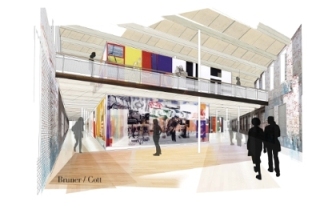Sep 26 2015
Arup, a multidisciplinary engineering and consulting firm with a reputation for delivering innovative and sustainable designs, announced today the commencement of construction for renovations at the Massachusetts Museum of Contemporary Art (MASS MoCA).
 Massachusetts Museum of Contemporary Art, Gallery. Rendering copyright Bruner/Cott & Associates
Massachusetts Museum of Contemporary Art, Gallery. Rendering copyright Bruner/Cott & Associates
Arup is the structural engineer for the transformation of a 120,000 SF industrial mill building into a world-class contemporary art museum. Building 6 is the third phase of a 25-year museum master plan, and will make MASS MoCA the largest contemporary art museum in the U.S. Working directly for Bruner/Cott Architects and Planners, Arup is developing structural solutions that serve to implement the architect's vision to preserve and enhance the building's natural assets of openness, light, and texture, while bringing the 100-year old building into modern structural compliance by resolving inherent lateral deficiencies.
The existing warehouse building was originally constructed using a variety of materials, including brick, wood, reinforced concrete, and cast-iron. To highlight the integrity of the historical building features while bringing the structure into compliance with modern seismic lateral upgrade standards, Arup responded with structural solutions that solve aesthetic, programmatic, and functional needs. It designed steel-braced frames and foundations that integrate easily with existing wood features. As the architects sought ways in which they could open up gallery spaces and expose building elements, Arup installed structural steel to create expanded openings and column free zones by transferring large weights to the reinforced foundation. Keeping some of the steel transfers exposed is a design element consistent with other buildings on the campus, and creates an industrial aesthetic that is simultaneously rudimentary and graceful.
"Arup is creative and respectful of the design work we have established on the museum campus. Their thinking enabled some meaningful and dynamic interventions to make this new gallery space. Together, we found ways to double and triple-use the structural retrofits to carry gravity, seismic, or winds loads in a way that will also be a meaningful part of the finished space," said Jason Forney, principal at Bruner/Cott. "They were able to balance design, cost and schedule considerations, and they navigated the new Massachusetts existing building code effectively."
Arup performed on-site investigation of the structure and existing building system to determine which elements could be retained safely, economically, and sustainably. With an eye towards forthcoming exhibit needs and the potential for additional load bearing components, Arup's structural design is flexible to accommodate future improvements. Early foundation phase work, while unglamorously hidden in the basement crawlspace level, was prudently accepted by the owner and methodically implemented by Waterman Excavating to serve as key elements enabling the installation of follow-on lateral upgrades and facilitation of future MEP work by creating a far safer usable basement zone.
"Existing building renovations are a particular strength for Arup's structural team," said Jimmy Su, associate with Arup. "The complexities and challenges in this building type require a blend of engineering artistry, with pragmatic approaches to structural integrity, safety, and practicality. We thoroughly enjoy the intersection of these elements, and are thrilled to be able to apply them to the renovation of this Mass MoCA building."
Additional similar historic existing building renovation projects include the Cutter and Ziskind Houses at Smith College, the Smith Campus Center at Harvard University, and the Bruce C. Bolling Building in Boston's Roxbury neighborhood.